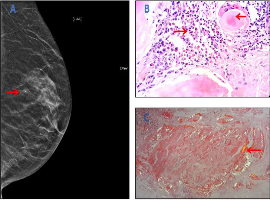Claire Comerford1*, Martin J O’Sullivan2, Brian Pierce3, Alissa Connors2, Linda Feeley3 and Oonagh Gilligan1
1Department of Haematology, Cork University Hospital, Cork, Ireland
2Department of Breast and General Surgery, Cork University Hospital, Cork, Ireland
3Department of Pathology, Cork University Hospital, Cork, Ireland
*Corresponding author: Claire Comerford, Department of Haematology, Cork University Hospital, Cork, Ireland, E-mail: claire.comerford@ucdconnect.ie
Received: April 07, 2021; Accepted: April 14, 2021; Published: May 05, 2021
Citation: Comerford C, J O’Sullivan M, Pierce B, et al. A Case of Localised Breast AL Kappa type Amyloid Deposition. Clin Image Case Rep J. 2021; 3(4): 157.


